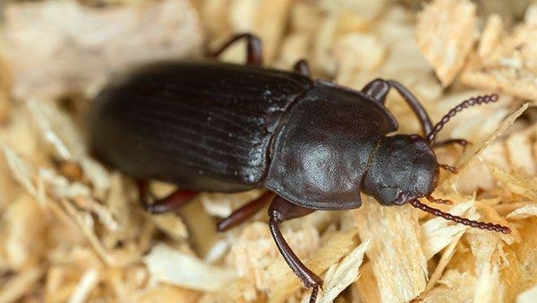Whom do you allow inside your pantry? Your family? Your friends? What about random people that visit your home for the first time? Most homeowners have a bit of a lock and key on whom they allow to rummage through their food supplies. Certain individuals who are certainly not allowed to steal cereal are bugs.
Every year pantry pests invade homes here in Fort Worth. These invasive insects are not only frustrating to deal with but also a quick way to lose control over your food stores. To help you keep pantry pests from contaminating your stored goods, here are six easy ways to keep them out of your home.
Which Pantry Pests Live In Fort Worth?
Before we give you some practical steps to prevent pantry pests, let’s first discuss which ones live in Fort Worth. Here is a short list to give you a good idea:
- Flour Beetles: The flour beetle is 3-4 mm long as an adult, reddish-brown, and has an elongated body with short antennae.
- Cigarette Beetles: The cigarette beetle is 2-3 mm long as an adult, light brown, and has a humped appearance and a head that is barely visible from above.
- Drugstore Beetles: The drugstore beetle is 2-3.5 mm long as an adult, brown, has an oval-shaped body, and wing covers that are lined with parallel rows of deep punctures or pits.
Interestingly, adult pantry pests do not eat stored foods. They invade stored dried foods in order to lay their eggs. These eggs mature and hatch into larvae. It is the larvae that feed on and contaminate the food inside pantries.
Step One: Seal Your Home’s Exterior
Pantry pests get into homes in many ways. One way is by crawling in through gaps and cracks in the exterior of homes and other buildings. To make sure these pests don’t crawl into your living areas, use a caulking gun to seal off gaps and cracks in your home’s exterior foundation and spacing around window/door frames. In addition to this, repair damage to weatherstripping, door sweeps, and window/door screens.
Step Two: Store Food Properly
It is easier for a pantry pest to invade a cardboard box than a sealed Tupperware container. For this reason, we recommend repackaging dried foods into sealable containers after returning home from a trip to the supermarket. Foods you should always do this with include cereal, dried beans, rice, and pet food.
Step Three: Store Seasonal Decor Properly
Pantry pests love hiding inside seasonal decor boxes. This is why influxes of pantry pest infestations happen around the holidays. To prevent this from happening in the future, store these seasonal items inside large sealable totes.
Step Four: Inspect Boxes Of Food Before Buying
Sometimes pantry pests invade boxes of food before you purchase them. Next time you purchase dried food at the supermarket, check the boxes for holes, rips, or other forms of damage pantry pests may have used to get inside.
Step Five: Clean Your Pantry Regularly
A clean pantry is an unattractive pantry to pantry pests. We recommend thoroughly cleaning food storage areas once a week to limit attractants that draw in unwelcome guests.
Step Six: Get A Professional Involved
At All-Safe Pest & Termite, we cannot prevent pantry pests from riding into your home inside boxes of food. What we can do is ensure these pests do not invade through your home’s exterior. Using industrial-grade products and advanced pest control strategies, we will give your home the absolute best defenses against pantry pests. Call today to learn more about our general pest control plans and find one that will keep pantry pests out of your Fort Worth home.

